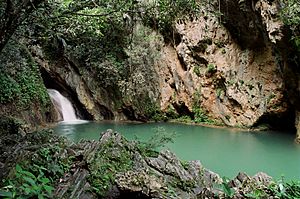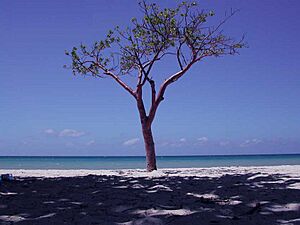Topes de Collantes facts for kids
Quick facts for kids Topes de Collantes |
|
|---|---|

Topes de Collantes
|
|
| Location | Cuba |
| Nearest city | Trinidad |
Topes de Collantes is a special nature park located in the Escambray Mountains in Cuba. It's also the name of the third tallest mountain peak in this park. There's a small town and a place for tourists there, all called Topes de Collantes.
Contents
Exploring Topes de Collantes' Location
Topes de Collantes means "Collantes' Highs." This area is about 800 meters (2,625 feet) above sea level. It's part of the Escambray mountain range. Other tall peaks here include Potrerillo peak, which is 931 meters (3,054 feet) high, and San Juan peak, the tallest at 1,140 meters (3,740 feet).
These mountains stretch across three central provinces of Cuba. These are Villa Clara Province to the north, Cienfuegos Province to the west, and Sancti Spiritus Province to the east.
The winds from the Atlantic Ocean bring a lot of rain to the northern side of the mountains. This makes it a perfect home for many plants and animals. The southern side is drier. It has important natural areas, including two famous UNESCO World Heritage Sites. These are the Valley of the Sugar Mills and Trinidad city. Both show how rich colonial Cuba was in the early 1600s.
Discovering the Wildlife and Plants
Nature is the main reason people visit Topes de Collantes. You can find caves, rivers, waterfalls, and natural pools with clear water. The mountain hills are surrounded by mariposa (butterfly lily), which is Cuba’s national flower. From June to early September, these flowers fill the air with a soft, unique smell.
This area is a tropical rainforest. It is home to over 40 types of orchids and 100 types of ferns. Seven of these ferns are like tall palm trees, growing up to 6 meters (20 feet) high. You can also see wild plantain and banana trees, jasmine, begonias, and many types of ginger. About 40 kinds of coffee plants grow here too. All these plants grow under the shade of huge trees like 40-meter (131-foot) tall pines, eucalyptus, West Indian mahogany, and magnolias.
Many important animals live here too. These include the Cartacuba (Todus multicolor), the Cuban ivory-billed woodpecker, unique hummingbirds, and the tocororo (Priotelus temnurus). The tocororo is Cuba's national bird.
A Look at Topes de Collantes' Past
In 1954, coffee farmers lived in this area. At that time, President Fulgencio Batista ordered a very large hospital to be built here. It was an Art Deco style building, almost like a battleship. It was meant for people with tuberculosis. People say his wife, Martha, was sick and loved the place. She convinced Batista to build a small house for her there too.
After the Cuban Revolution, the hospital became a school. In the mid-1970s, it was changed back into a hotel. This hotel specializes in rehabilitation and special therapies. The Kurhotel is also known for its huge collection of Cuban art. It has almost 800 pieces from famous Cuban painters. These artworks are in its 210 rooms, lobbies, and hallways.
Because of this, a small town for workers grew around the hotel. In the 1980s, the Mountain Campus of Las Villas University was built here. Since Topes de Collantes is close to Trinidad city and the beaches of Ancon, a few more hotels and a resort have been built for tourists.
Exciting Places to Visit
Topes de Collantes has many popular places to explore. Here are some of the best trips:
Caburni Falls: A Waterfall Adventure
The Caburni Falls are about 3 kilometers (1.9 miles) away. This is the most popular hike. You walk through coffee farms and past traditional houses. The path leads to cliffs and then to the Caburni river. The river falls 62 meters (203 feet) down a rock wall into several natural pools.
La Batata: Underground River Caves
La Batata is 3 kilometers (1.9 miles) from the town. It offers beautiful views. The trip ends in an underground river and cave system. This system has several levels of natural ponds to explore.
Hacienda Codina: A Ranch with Many Sights
Hacienda Codina is a ranch with different attractions. You can try medicinal mud baths and see gardens with medicinal and pretty plants. The orchid collection has over 40 local types, including bamboo. There's also Altar’s cave. A secret passage from this cave leads to a natural lookout. From there, you can see the southern mountains, the Valley of the Sugar Mills, Trinidad, and Ancon.
Paseo Ecologico: A Nature Walk
The Paseo Ecologico is an Ecology walk, about 1 kilometer (0.6 miles) long. It connects the Kurhotel with the "Los helechos" hotel. This path is full of mariposa shrubs and tall ferns. They grow under the shade of pine and eucalyptus trees.
Parque La Represa: A Special Park
Parque La Represa is a 1 square kilometer (0.39 square mile) park. It was built around the original house for Batista’s wife, Martha. The park is on the banks of the Vega Grande River. It has an arboretum with over 300 types of exotic plants. The tallest and oldest mahogany tree ever found in Cuba lives here.
Snak Bar “El Mirador”: The Lookout Spot
The Snak Bar “El Mirador” means "The Lookout." It is on the way down to Trinidad. It sits between the Valley and the mountains, about 600 meters (1,969 feet) above sea level. From here, you can see the city of Trinidad and the peninsula below.
Close by are the white sands and blue waters of Ancon and La Boca beaches. The UNESCO World Heritage Site of Trinidad is also nearby. It has about 500 years of history in its stone streets and colonial buildings.
Images for kids
See also
 In Spanish: Gran parque natural Topes de Collantes para niños
In Spanish: Gran parque natural Topes de Collantes para niños






